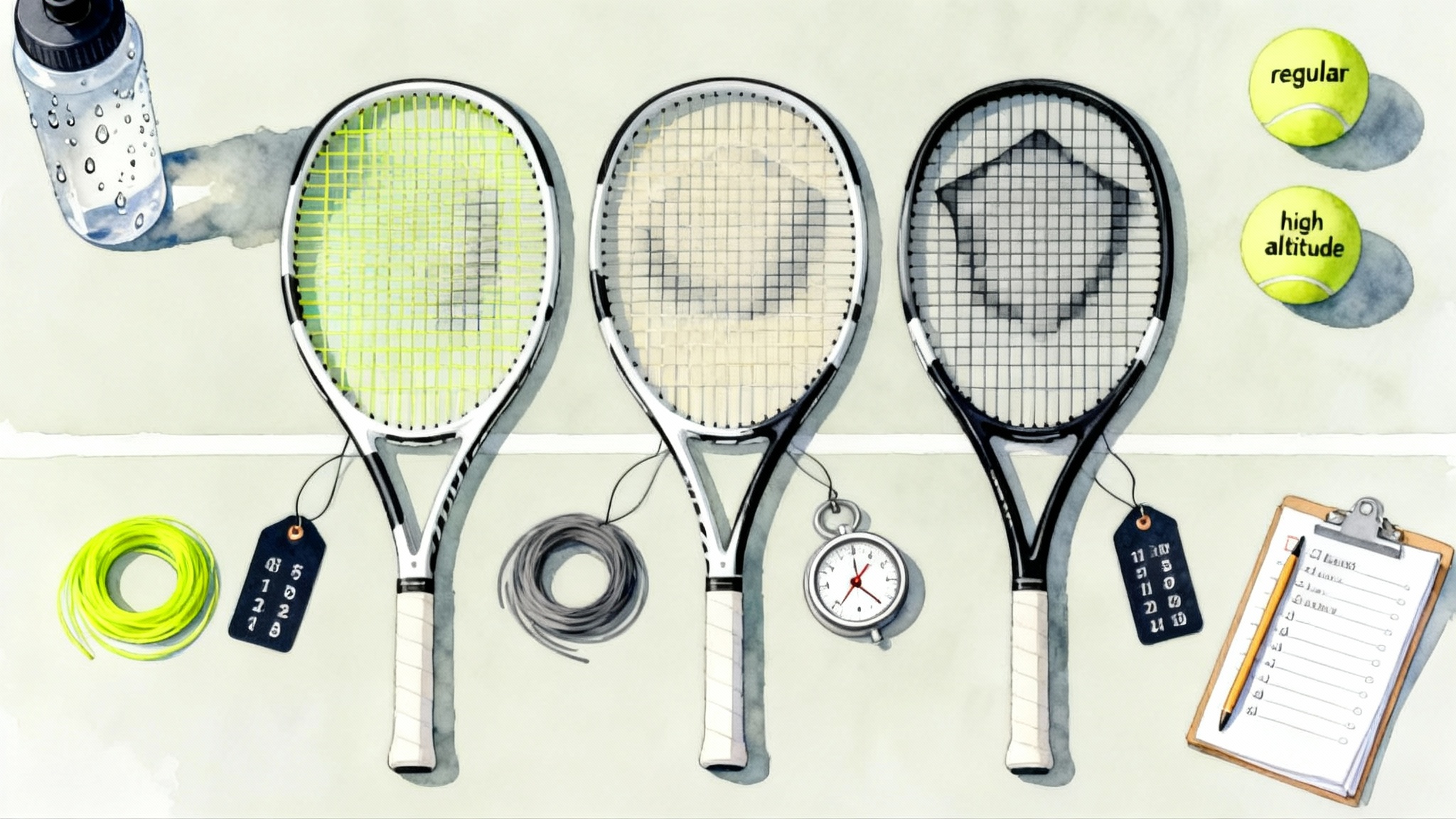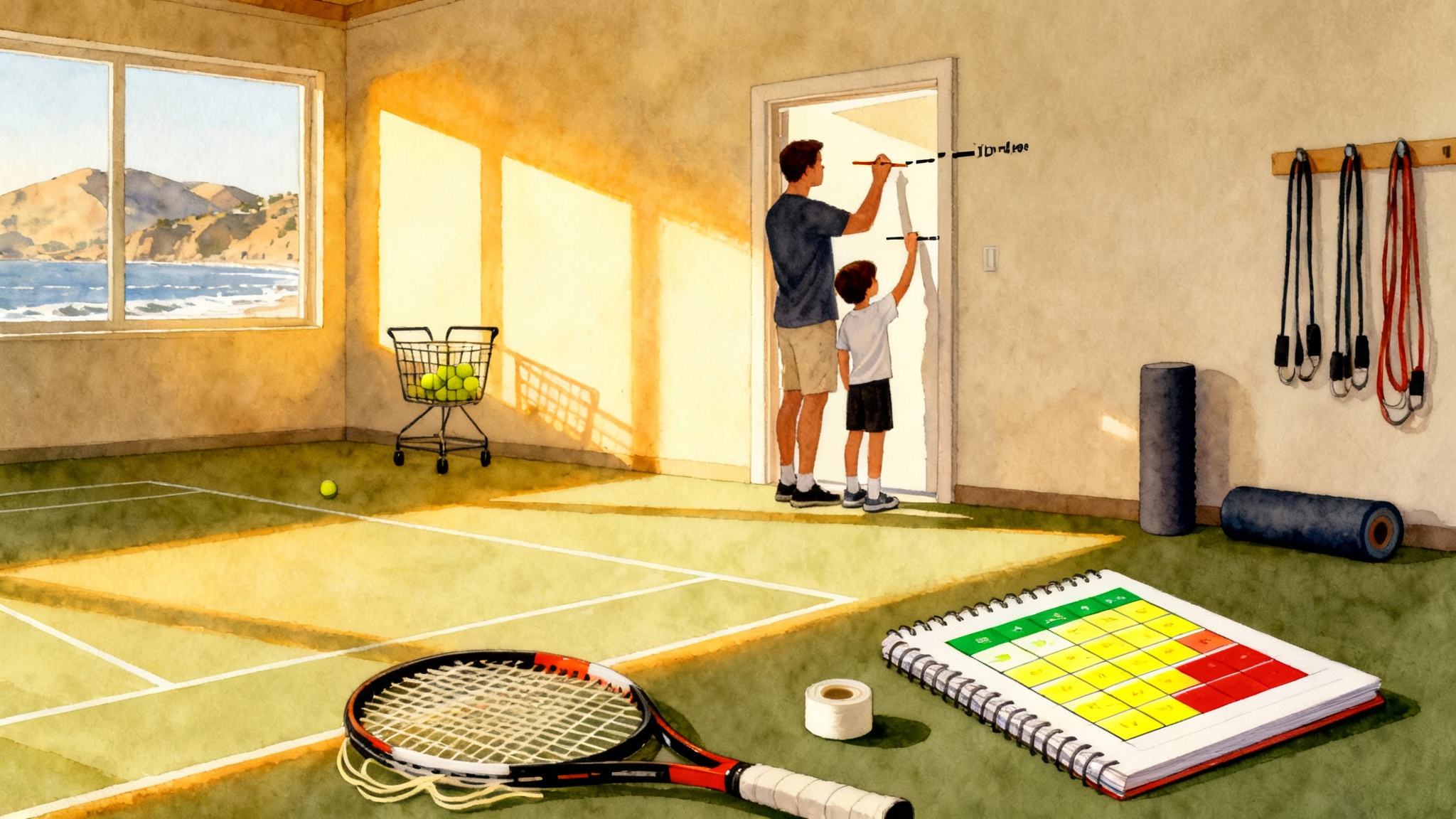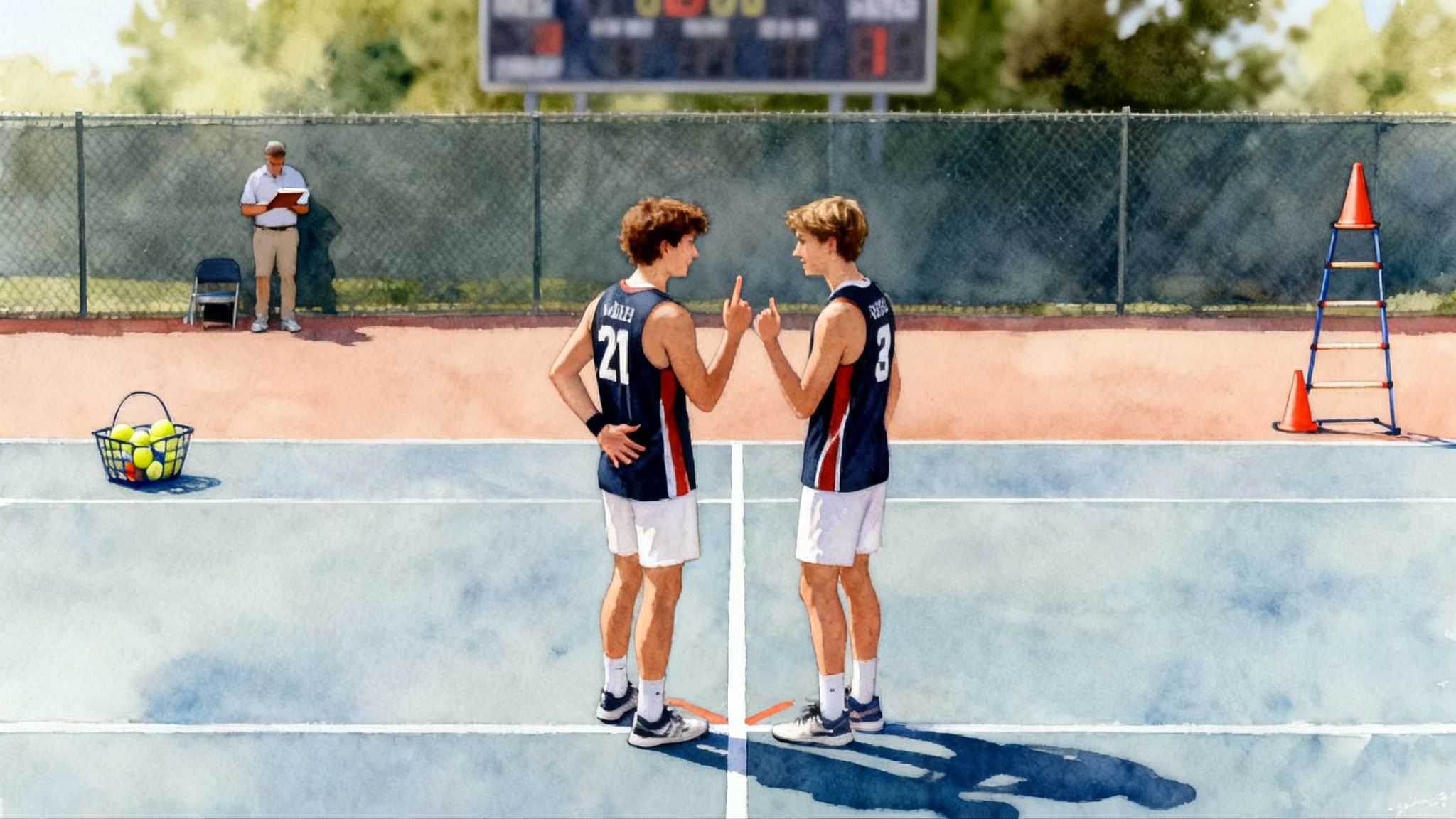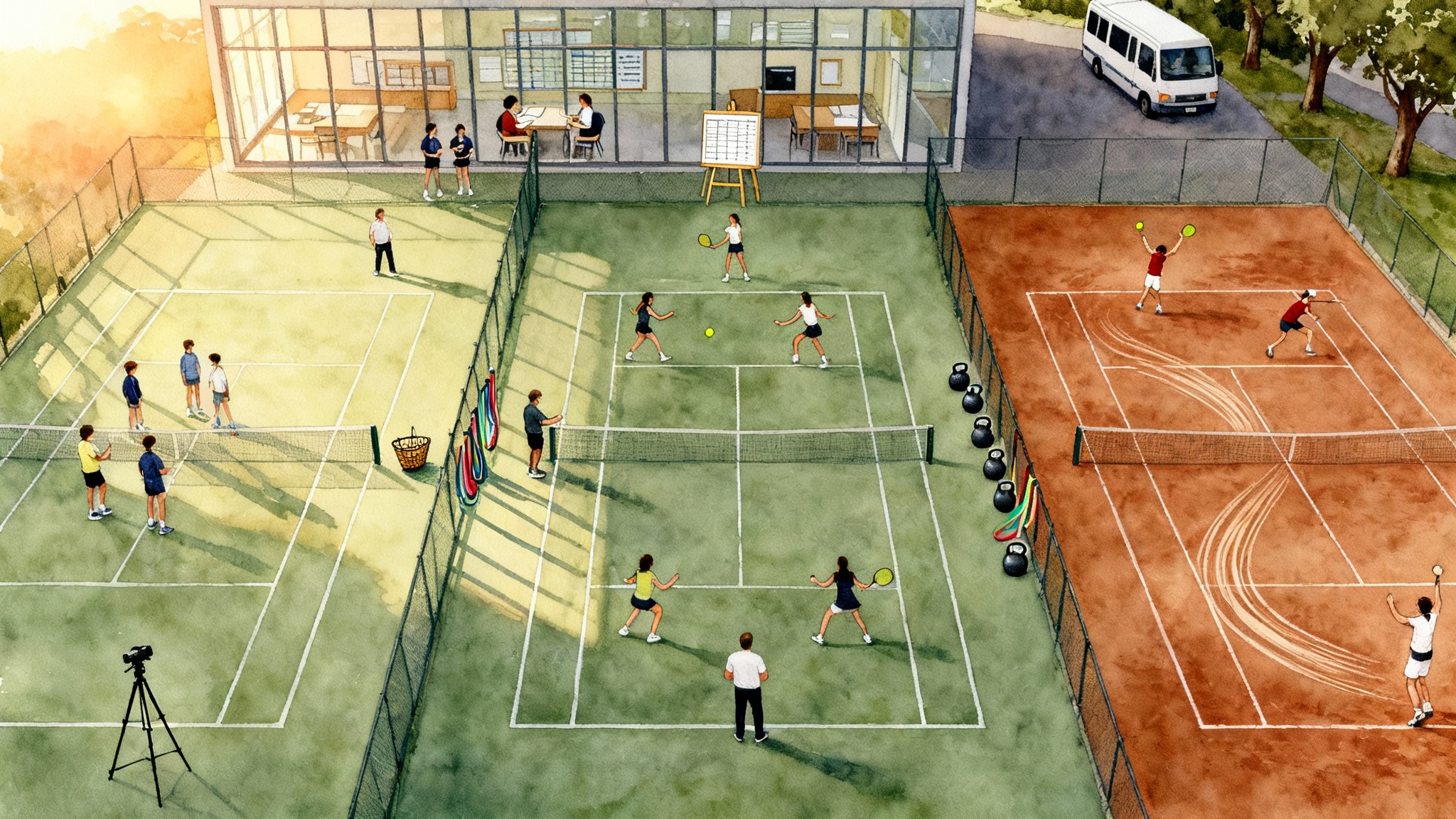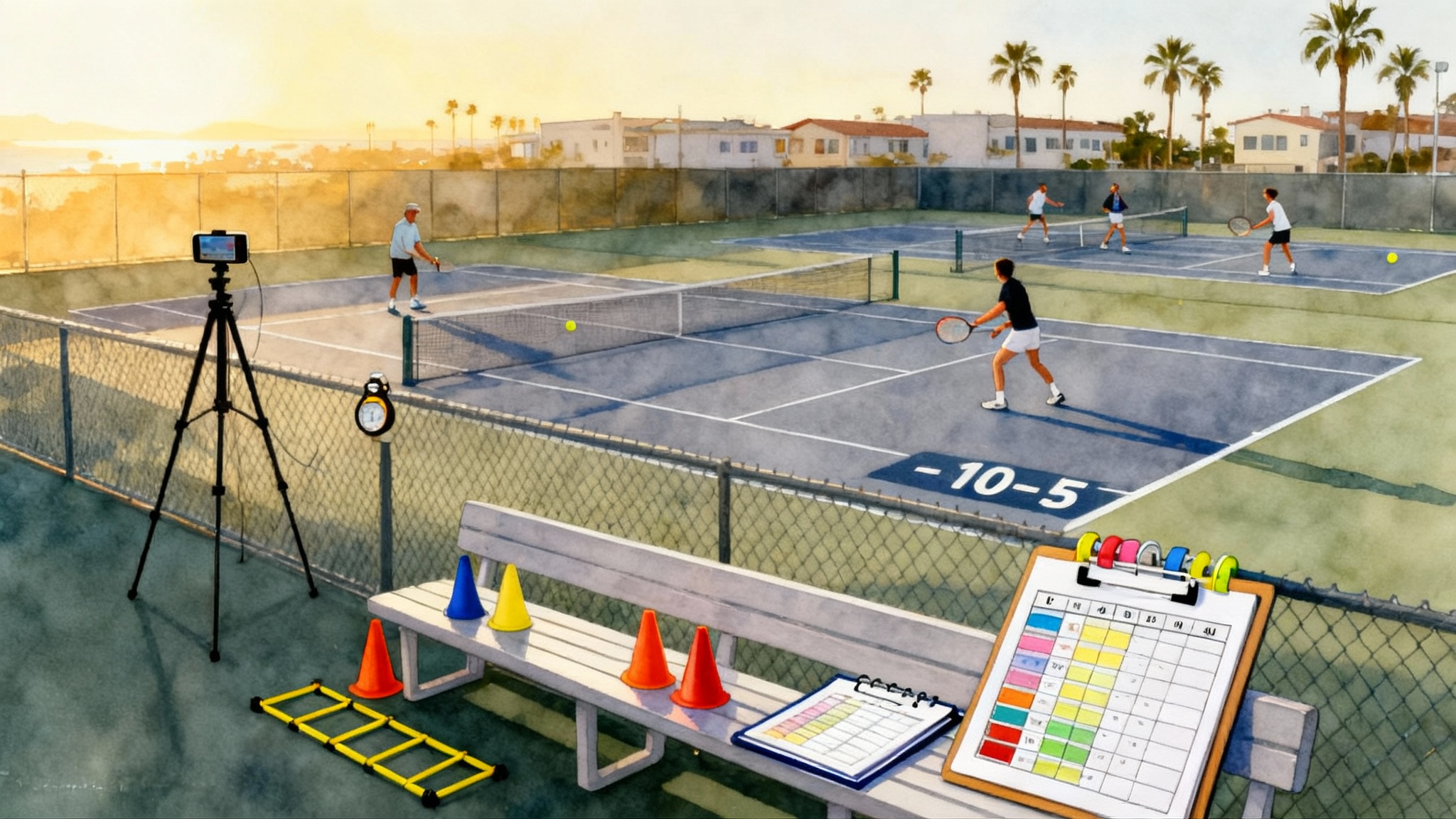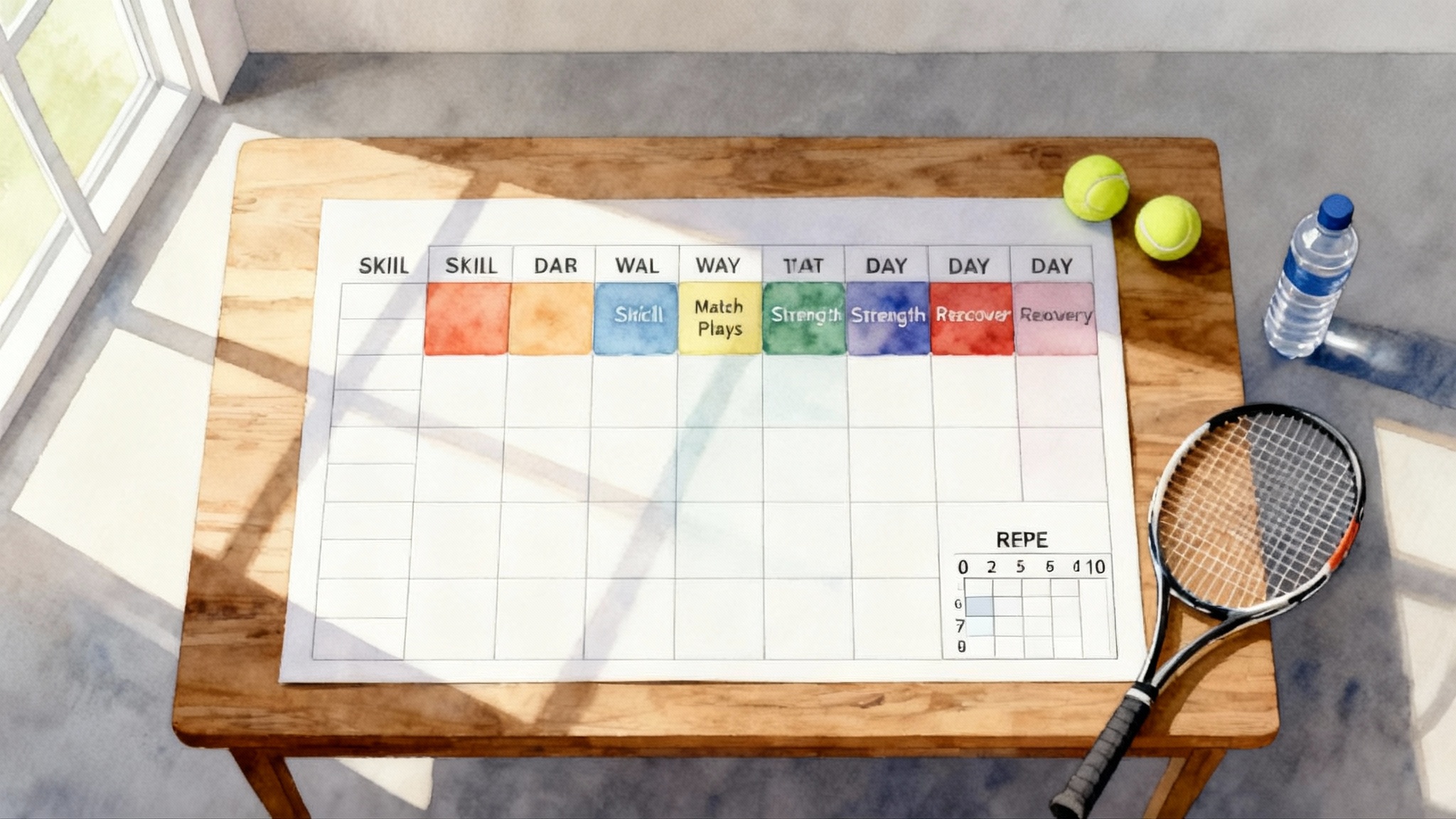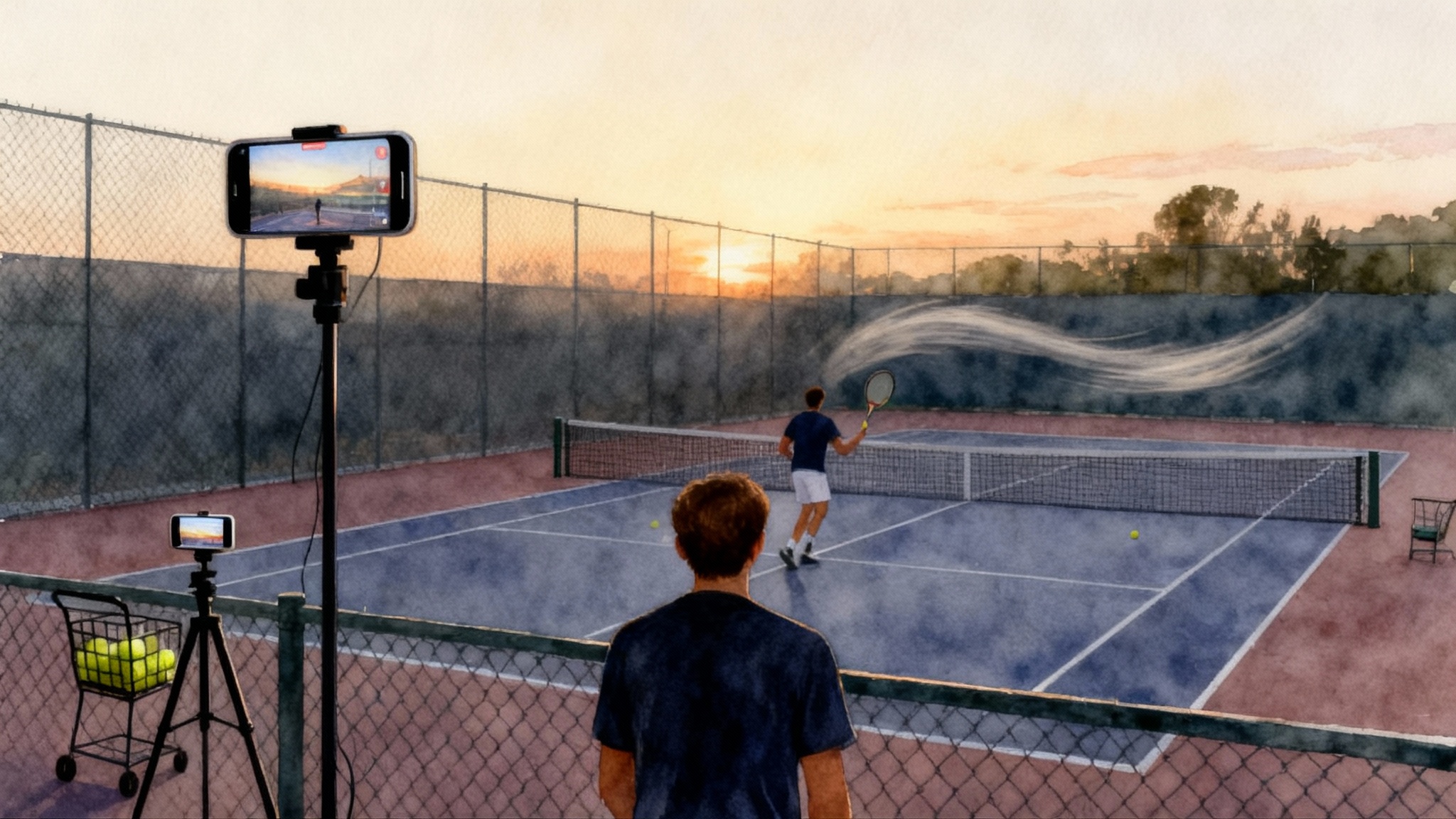Yellow Ball Ready 2025: Skills from Red Orange Green to Full Court
A practical 2025 roadmap that tells parents, juniors, and adult returners exactly when to move from red to orange to green to full yellow. Clear pass or fail benchmarks, a six week plan, and a transition checklist to prevent burnout.
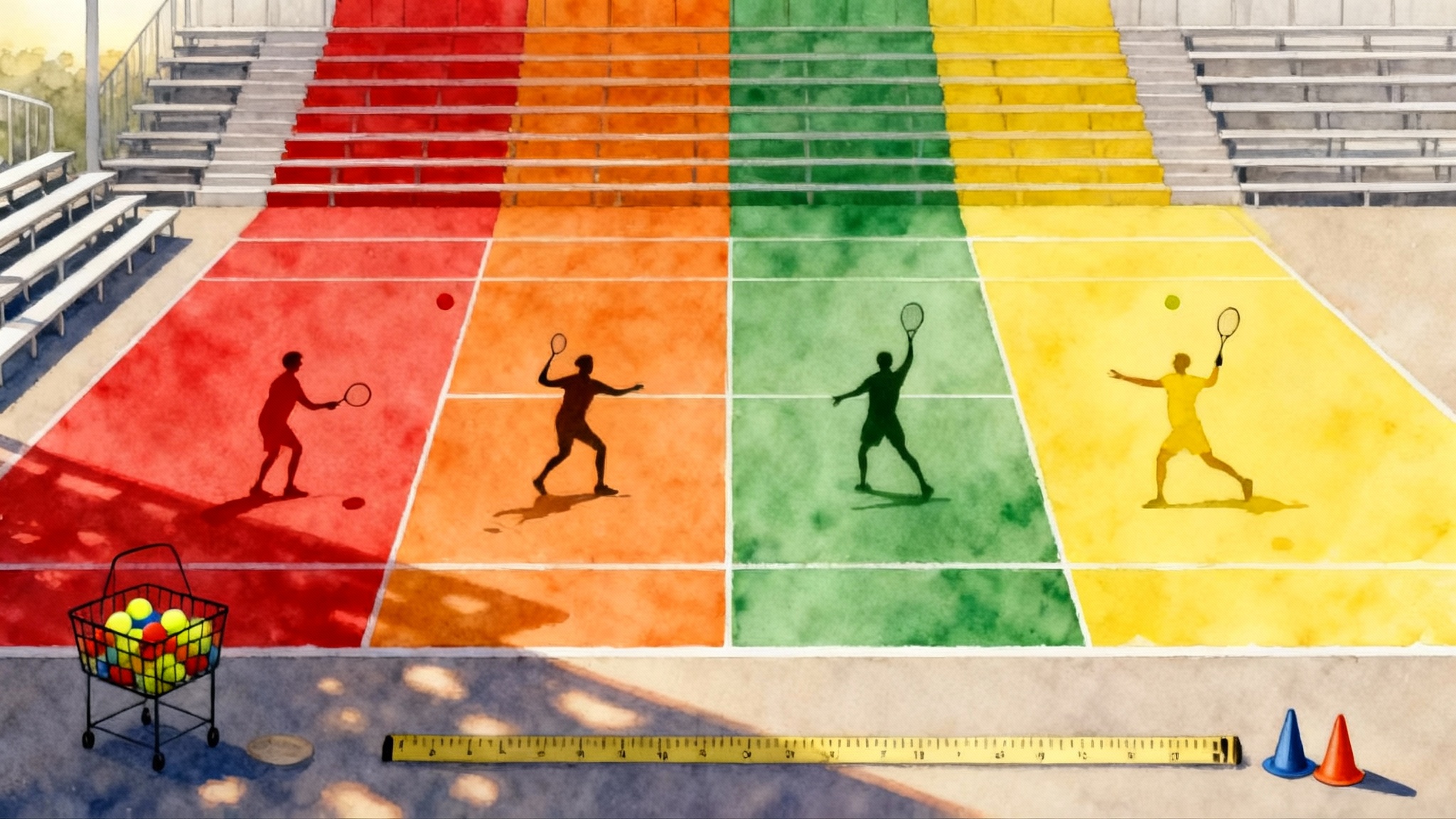
Why a skill-based roadmap beats age-based guesswork
If you have ever wondered when to move a player up from red to orange to green to full yellow, you are not alone. Most families and many adult returners rely on age or gut feel. In 2025, we can do better with skill-based benchmarks that are objective, simple to measure, and easy to repeat. You will see the right jumps at the right time, and you will avoid the injuries and confidence dips that come from moving up too soon.
Red, orange, and green are not marketing labels. They are specific court sizes and ball speeds created to match how players learn. Red balls are roughly 75 percent slower than yellow, orange about 50 percent slower, and green dot about 25 percent slower. Courts scale up from 36 feet to 60 feet to the full 78. For quick reference, see the ITF red, orange, green specs. This guide gives you clear pass-or-fail benchmarks for rally length, spin and control, serve-to-target accuracy, footwork, and decision making. You will also get a six-week step-up plan with at-home mini court exercises, sizing rules for racquets and balls, and a transition checklist inspired by the Beverly Hills Tennis academy junior pathway so you know exactly when to move up without burnout or guesswork.
The equipment rules that speed progress
Correct gear lets the technique show up. Wrong gear hides it.
-
Ball choice
- Red foam or red felt: indoor spaces and very new players. Slows the game so shapes and spacing can be learned.
- Orange: medium pace and good for players who can rally from a 60 foot court and are beginning to place the serve.
- Green dot: full court feel with lower pace and bounce. Great for the final technical polish before yellow. Also excellent for adult beginners and returners who want less stress on the arm and more time on contact.
-
Racquet length by player height
- Under 3 feet 11 inches: 19 inch racquet
- 3 feet 11 inches to 4 feet 4 inches: 21 inch racquet
- 4 feet 4 inches to 4 feet 8 inches: 23 inch racquet
- 4 feet 8 inches to 5 feet: 25 inch racquet
- 5 feet and up: 26 or 27 inch racquet depending on strength and control
-
Adult returner starter specs
- Head size: 100 to 105 square inches for a larger sweet spot
- Weight: about 10 to 10.8 ounces strung for stability without fatigue
- String pattern: 16 by 19 for easy spin
- String tension: lower half of the recommended range to improve comfort
-
Court sizes to use
- Red stage: 36 by 18 feet
- Orange stage: 60 by 21 feet singles, 27 feet for doubles practice
- Green and yellow stages: full 78 by 27 feet
For a simple official overview, the USTA equipment guidelines match the heights, ball types, and court sizes above.
Pass or pause: benchmarks that make the next step obvious
Use these practical pass-or-fail tests in two separate sessions during a two week period. If the player passes both times, move up. If not, keep practicing and retest.
Red stage: build shapes and spacing
-
Cooperative rally
- Pass: 12 ball rally from 36 foot baseline to baseline with red ball. Net clearance about 3 to 5 feet.
- Pause: fewer than 8 balls on average or clearance under 2 feet.
-
Serve to target
- Setup: mark a 6 by 6 foot target in each service box diagonal.
- Pass: 3 of 5 underhand or simple overhead serves land in the target on both sides.
- Pause: fewer than 2 of 5 in either box.
-
Spin and control test
- Pass: 8 of 10 topspin roll ups clear the net by 3 feet, bounce beyond the service line, and do not sail long.
- Pause: more than 3 balls land short of the service line or fly long.
-
Footwork and decision drill
- Drill: coach or parent alternates a neutral ball and a short ball. Player rallies crosscourt on the neutral, then steps in and sends the short ball back deep crosscourt.
- Pass: 7 of 10 correct decisions with recovery steps to the middle after each shot.
- Pause: player chases without split step or hits the short ball back short. If stops feel shaky, review the faster stops and safer knees guide.
When to move from red to orange: pass the four tests above on two separate days.
Orange stage: build direction and depth
-
Crosscourt pattern
- Pass: 12 ball crosscourt rally on a 60 foot court on both forehand and backhand.
- Pause: average rally under 8.
-
Line change discipline
- Drill: two crosscourts then one down the line, repeat.
- Pass: 8 of 10 sequences completed with no net miss on the change of direction.
- Pause: more than 3 net misses or line change sprayed wide.
-
Serve placement
- Pass: 6 of 10 overhead serves hit either the T or the wide target on both sides. Net touch counts as a miss.
- Pause: fewer than 4 of 10 on either side.
-
Spin and height window
- Pass: 7 of 10 balls clear a visual window 2 to 4 feet above the net and land past the service line.
- Pause: recurring flat drives barely clear the net or sit short.
-
Return basics
- Pass: 7 of 10 returns of a firm feed land past the service line with height.
- Pause: blocks float short or spray long.
When to move from orange to green: pass all five on two separate days and complete one set to 6 games on the 60 foot court without a double fault streak of three.
Green dot stage: full court with time to spare
-
Deep control
- Pass: 7 of 10 crosscourts land in the last 6 feet of the court with 3 foot net clearance.
- Pause: depth collapses when pace increases.
-
Backhand reliability
- Pass: 12 ball backhand crosscourt rally on a full court with green dot.
- Pause: average under 8 or repeated short balls.
-
Serve reliability
- Pass: first serves 7 of 10 in targets and second serves 6 of 10 in with visible topspin or slice shape.
- Pause: second serves sit flat or double fault rate above 30 percent.
-
Transition drill
- Drill: neutral ball, approach on the short ball, first volley deep, second volley controlled, finish point.
- Pass: 6 of 10 sequences without a volley into the net.
- Pause: approach shot lands short or volley swings are too big.
When to test yellow ball: pass the four green dot tests above, then run the yellow readiness tests below.
Yellow ball readiness: the final gate
-
Yellow ball rally test
- Pass: 12 ball crosscourt on both sides, plus 8 ball down the line on choice side.
- Pause: rallies collapse under yellow pace or height.
-
Serve to target on yellow
- Pass: 6 of 10 first serves to either wide or T on both sides; 6 of 10 second serves in with spin to body or T; double fault rate under 20 percent in practice.
- Pause: forced flat second serves or toss chase.
-
Return test
- Pass: 7 of 10 returns in play against a firm first serve; 8 of 10 against a second serve.
- Pause: jammed body returns or slices that float short.
-
Movement and decision
- Pass: player split steps on time, recovers to center within two steps, and can play one more ball after a deep shot at least 6 of 10 times.
- Pause: late contact followed by no recovery.
If all four pass twice in two weeks, the player is yellow ball ready.
A six-week step-up plan with at-home mini court work
Every week includes a court session and a mini court home session. Mark a 10 by 20 foot space with painter’s tape in a driveway or hallway. Use a foam or red felt ball for indoor work.
-
Week 1: rhythm and spacing
- Court: red or orange depending on current stage. Goal is 12 ball cooperative rally. Serve toss ladder: three heights marked with cones, land the toss in the zone 8 of 10 times.
- Home: 50 shadow swings with checkpoints. Pause at contact and finish with the racquet above shoulder. Wall rally: 5 sets of 20 gentle bumps without letting the ball drop.
-
Week 2: height and spin control
- Court: aim for a three foot window above the net. Two crosscourts then one line pattern. Serve to 6 by 6 boxes 20 reps per side.
- Home: windshield wiper spin drill. Brushing the ball upward against a wall for 4 sets of 25. Sock toss serve rhythm: 30 toss and swing motions without a racquet to feel balance.
-
Week 3: direction and recovery
- Court: crosscourt depth to last 6 feet of the court. Recovery rule: two steps back to center after every shot. Score 7 of 10 with proper recovery.
- Home: ladder steps or taped floor ladder for quick feet. 6 rounds of in in out out patterns. Add 3 sets of 10 split step and first move reps.
-
Week 4: serve and return focus
- Court: 40 serves. Goal is 60 percent to targets, then 10 second serves with visible spin. Return drill: coach feeds from the service line to simulate speed, player aims deep crosscourt. For a deeper look, see the return of serve mastery plan.
- Home: throw and catch for return timing. Partner stands 20 feet away and throws firm chest high tosses. Player split steps, catches, and shuffles back to center. 5 sets of 12.
-
Week 5: transition and net
- Court: approach plus two volleys drill, then overhead finish. Target is 6 of 10 clean sequences. Include one green dot session even if still on orange to experience deeper court.
- Home: volley wall bumps with continental grip. No backswing. 5 sets of 30 continuous contacts.
-
Week 6: mock test week
- Court: run the exact pass-or-pause tests for the desired next ball. Play one practice set using the correct court size.
- Home: mindfulness routine. Build a three step between points plan: deep breath, cue word like “loose,” and a simple target like “high crosscourt.” 10 minutes daily.
Tip for busy families: if you miss a day, repeat that week. Do not rush to the next color if the benchmarks are not yet consistent.
When to pause or step back
- Pain or sudden drop in consistency: move to a softer ball for the next three sessions and reduce serve volume.
- Double fault strings of three or more: return to half court serves with green dot or orange until second serve shape returns.
- Rally height drops below two feet over the net: return to red or orange for one week of window training.
- Motivation dips: schedule a fun team session or target games with simple scoring before returning to tests.
Stepping back is not failure. It is a fast way to protect the habit quality you will need at yellow ball speed.
Transition checklist inspired by Beverly Hills Tennis’s junior pathway
Use this checklist to move from one color to the next. Check all boxes in two separate sessions.
-
Technical
- Forehand and backhand show a unit turn, contact out in front, and balanced finish.
- Second serve has visible spin shape, not a flat push.
- Volleys are short back and through with stable wrist and 8 of 10 land past the service line.
-
Tactical
- Crosscourt first as a rule, then line change when balanced.
- Short balls trigger an approach and split step before the first volley.
- Defensive balls above shoulder trigger height and reset, not a flat swing.
-
Movement
- Split step just before opponent contact on 8 of 10 points.
- First step is decisive toward the ball, then two steps back to center.
-
Scoring and habits
- Knows game scoring, tiebreak basics, and changeover routine.
- Owns a between points routine: breath, cue word, and target image.
-
Match play composure
- Accepts calls and setbacks without visible frustration for an entire set.
-
Health
- No elbow or shoulder pain during or after serving.
If each section is checked twice in two weeks, the move is safe.
Special notes for parents, juniors, and adult beginners
- Parents of young players: keep a simple progress board at home. When your child passes a test, they put a sticker on the board. Celebrate consistency rather than power.
- Juniors who aim for team tennis: use green dot for advanced pattern work, then test yellow weekly until the four yellow gates are passed.
- Adult beginners and returners: green dot is your friend. It lets you find rhythm and confidence while protecting the arm. Many adults thrive by playing two months of green dot matches before moving to yellow.
For printable checklists, copy these tests into a one-page tracker and bring it to the court each week.
How to run a Yellow Ready Day at home or at the club
-
Gear
- 8 cones or water bottles for targets
- Painter’s tape or chalk
- Phone timer and a notepad
-
Flow
- Warm up for 10 minutes with mini tennis and dynamic footwork.
- Pick the relevant tests from the lists above.
- Measure only what matters: rally counts, serve in the target or not, correct decision or not.
- Record scores and feelings. Repeat the test on a second day.
-
Scoring rubric
- Pass: meets or exceeds thresholds on two days.
- Close: within one rep of the threshold on two days. Spend one week on targeted drills and retest.
- Pause: misses by two or more reps. Step back to the softer ball for three sessions and rebuild.
What to train after you move up to yellow
The first month on yellow should lock in depth, second serve shape, and return height.
-
Week 1: height and deep crosscourt
- Goal: 7 of 10 balls in last 6 feet with three foot clearance.
-
Week 2: serve to three targets
- Goal: 6 of 10 to wide, T, and body on both sides. Second serve spin every time.
-
Week 3: return plus first ball
- Goal: return deep crosscourt and recover. Play a neutral ball rally to 6 shots on average.
-
Week 4: approach and finish
- Goal: convert 6 of 10 short balls into a point with approach, volley, and a finishing ball.
Keep a simple sheet of these goals on your bag. If any metric slips for a week, spend two sessions with green dot to reset the shape, then return to yellow.
A smart conclusion for 2025
Players do not get better by forcing a faster ball. They get better by repeating the right shapes and choices at a speed they can control. That is the power of a skill-based roadmap in 2025. Use the tests, run the six-week plan, and hold yourself to the pass-or-pause standard. When the player is truly yellow ball ready, it will be obvious on two separate days, not lucky for one afternoon. That is how you move up with confidence and stay there.
